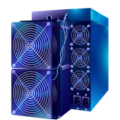MicroBT Whatsminer M21
Whatsminer M21 insights de rentabilité alimentés par des données en temps réel : Découvrez combien votre Whatsminer M21 Vous pouvez gagner en utilisant notre calculateur avancé de mineur ASIC. Nous utilisons des données de récompense de minage en direct et prenons automatiquement en compte les coûts d'électricité, vous donnant un aperçu clair de vos retours potentiels quotidiens, mensuels et annuels.
Analyse de rentabilité
Ici, vous pouvez voir une analyse détaillée de la rentabilité des mineurs, mise à jour en temps réel.
| . | Revenu | Dépense | Profit |
|---|---|---|---|
|
Quotidien
|
$1.41 | $3.57 |
$-2.16
|
|
Mensuel
|
$42.34 | $107.14 |
$-64.80
|
|
Annuel
|
$515.09 | $1,303.49 |
$-788.40
|
À propos de la MicroBT Whatsminer M21 (31TH/s)
En savoir plus sur cet miner ASIC, y compris ses spécifications, ses performances, sa consommation d'énergie et sa rentabilité.
The MicroBT Whatsminer M21 arrives like a precise instrument forged for the alchemy of SHA-256, offering a steady 31 TH/s while drawing about 1860 W from the grid and achieving roughly 0.06 J/GH, a balance of brute hashing and economical energy draw that makes it attractive to solo hobbyists and professional rack operators alike; built-in power supply and robust thermal management simplify installation and lower the barrier to entry, while its ASIC architecture is tailored to mine Bitcoin and allied coins sharing the SHA-256 family-Bitcoin Cash, Bitcoin SV, Namecoin, Ecash, Fractal Bitcoin and Peercoin-so operators can pivot across chains as conditions dictate. In practical terms the M21 rewards careful site planning: reliable mains, ventilation, rack space and monitoring for temperature and uptime will protect hashing continuity and ROI, and using pooled mining, firmware updates and quality cooling will maximize long-term performance. To translate raw hashes into operational decisions, a comprehensive profit calculator that models your hashrate, current network difficulty, block rewards and pool fees alongside electricity consumption and local rates will produce daily, monthly and annual yield projections to help compare setups, optimize energy strategies and decide whether to scale, diversify coin targets, or focus on efficiency improvements that tilt marginal gains into consistent advantage.
Découvrez quelles cryptomonnaies ce mineur peut extraire
Explorez les cryptomonnaies qui peuvent être minées en utilisant MicroBT Whatsminer M21 (31TH/s), y compris la rentabilité détaillée.
Convertisseur de devises
Calculer les cryptomonnaies exploitables dans n'importe quelle devise.
| Pièce | Revenu/Jour | Profit/Jour |
|---|---|---|
|
$1.31
$
0.00001288

|
$-2.26
$
-0.00002224

|
|
|
$1.32
$
0.00001294

|
$-2.25
$
-0.00002210

|
|
|
$1.29
$
0.00254397

|
$-2.28
$
-0.00449177

|
|
|
$1.41
$
3.51

|
$-2.16
$
-5.40364146

|
Performance Historique de Minage
Voir les tendances de performance des MicroBT Whatsminer M21 (31TH/s) sur des périodes hebdomadaires, mensuelles et annuelles.
Rentabilité historique
Voir les tendances historiques des revenus et des bénéfices pour ce mineur.
SHA-256 Générations de mineurs
Évolution du matériel de minage de cryptomonnaies au fil des ans, avec la génération actuelle mise en avant pour référence.
Génération 1
26 MineursGénération 2
26 MineursGénération 3
26 MineursGénération 4
26 MineursGénération 5
26 MineursGénération 6
26 MineursGénération 7
27 MineursGénération 8
27 MineursGénération 1
26 MineursGénération 2
26 MineursGénération 3
26 MineursGénération 4
26 MineursGénération 5
26 MineursGénération 6
26 MineursGénération 7
27 MineursGénération 8
27 MineursPlus d'informations sur le
Apprenez-en davantage sur le MicroBT Whatsminer M21 (31TH/s)
The MicroBT WhatsMiner M21 is a purpose-built SHA-256 ASIC that produces a steady 31 TH/s while drawing roughly 1860 W and delivering about 0.06 J/GH, positioning it as a high-throughput, energy-aware choice for mining Bitcoin and SHA-256 siblings such as Bitcoin Cash, Bitcoin SV, Namecoin, Ecash, Fractal Bitcoin and Peercoin; its 12 nm ASIC core, dual high-speed fans and aluminum-alloy shell form a compact thermal-management package, while the integrated power supply simplifies cabling at the cost of demanding a stable incoming feed, and firmware that allows voltage tuning alongside automatic thermal throttling gives experienced operators the levers to tune efficiency versus reliability. Operationally this combination implies clear site requirements: disciplined electrical provisioning and surge protection or conditioning to prevent brownouts, structured airflow and rack spacing to avoid heat recirculation, acoustic mitigation where noise matters, and a maintenance cadence that anticipates fan replacement and PSU health-treat spare parts and firmware rollbacks as inventory items rather than afterthoughts. From a systems-strategy perspective, maximize long-term output by combining pooled mining for steadier revenue, proactive firmware updates that close vulnerabilities and refine power curves, and continuous monitoring of hash rate, temperature and uptime so that automated alerts can trigger rapid intervention; use a profitability model that integrates your measured hashrate, current network difficulty, block rewards, pool fees and actual measured power draw to produce daily, monthly and annual projections and run sensitivity analyses against difficulty shifts and utility rate changes to determine break-even horizons and whether to scale, diversify coin targets, or invest in efficiency upgrades. Consider also site-level optimizations such as grouping units to enable waste-heat capture, negotiating power delivery terms to lower effective energy cost per terahash, and planning for decommissioning or resale paths as network economics evolve. Above the metrics and checklists, treat the miner as a body at the threshold between life and silence: every watt sustains its work, every compromised connection risks the void, and the disciplined interplay of cooling, power stability and operational governance is what separates resilient, long-term hash production from intermittent, costly downtime.
Où acheter ?
Fournisseurs fiables et disponibilité actuelle sur le marché, présentant des fournisseurs vérifiés proposant cet ASIC miner ainsi que leurs derniers prix et informations de stock.
Aucune offre disponible
Il n'y a actuellement aucune offre pour ce mineur. Veuillez vérifier plus tard.
Spécifications techniques
Des spécifications matérielles détaillées et des capacités de minage pour MicroBT Whatsminer M21
Informations de base
Performance
Physical Dimensions
Cryptomonnaies minables



Information sur l'algorithme : SHA-256
Apprenez-en davantage sur le SHA-256 algorithme et son fonctionnement.
SHA-256 est une fonction de hachage cryptographique qui sert de colonne vertébrale à Fractal Bitcoin mécanisme de consensus proof-of-work. Cet algorithme traite des données d'entrée de n'importe quelle longueur et produit une valeur de hachage fixe, garantissant la sécurité et l'intégrité du processus de minage.
Pools de minage crypto
Connectez-vous aux pools de mining les plus fiables et maximisez votre efficacité de mining crypto avec un temps de disponibilité et une rentabilité optimisés.
Avis des utilisateurs
Voyez ce que les utilisateurs disent de ce mineur.
Aucun avis pour l’instant
Soyez le premier à évaluer ce mineur !
Questions Fréquemment Posées
Tout ce que vous devez savoir sur le MicroBT Whatsminer M21
Quelle est l'efficacité de la MicroBT Whatsminer M21 31TH/s?
Quel est le coût de l'électricité pour le MicroBT Whatsminer M21 31TH/s (USD)?
Quelle puissance consomme le MicroBT Whatsminer M21 31TH/s utiliser ?
Qui fabrique les Whatsminer M21?
Quel est le hashrate de le MicroBT Whatsminer M21?
Quelles cryptomonnaies peuvent être minées avec le MicroBT Whatsminer M21 31TH/s?
 NiceHash (BTC)
NiceHash (BTC)
 Bitcoin (BTC)
Bitcoin (BTC)
 Bitcoin Cash (BCH)
Bitcoin Cash (BCH)
 Fractal Bitcoin (FB)
Fractal Bitcoin (FB)
 Anglais
Anglais
 Allemand
Allemand
 Hongrois
Hongrois
 Néerlandais
Néerlandais
 Espagnol
Espagnol
 Français
Français
 Italien
Italien
 Tchèque
Tchèque
 Polonais
Polonais
 Grec
Grec
















